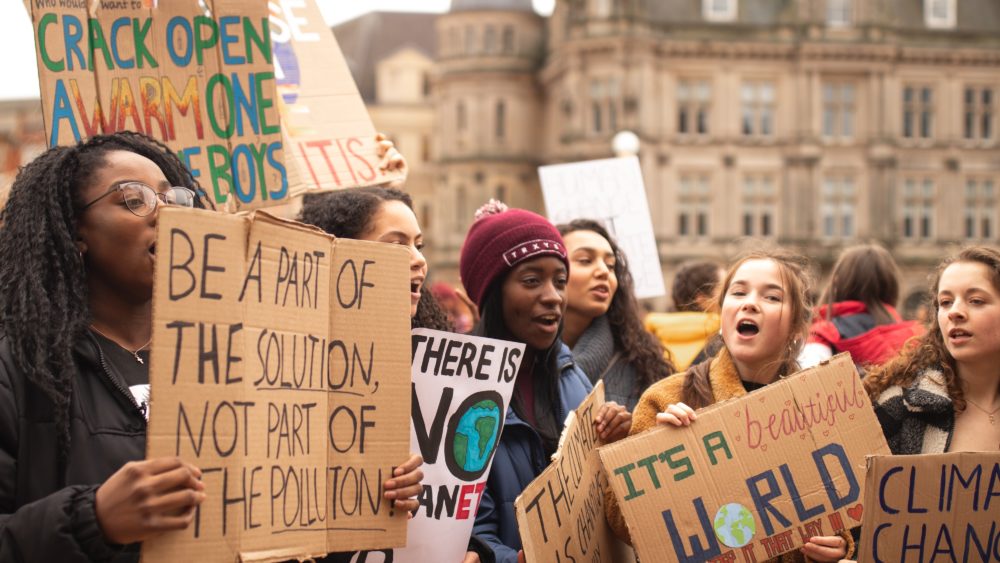The Last Carbon Problem
We know we have to reduce CO2 emissions to reach a Net Zero CO2 emissions steady state, in which whatever CO2 we do emit into the atmosphere is either matched by its return to the lithosphere, or, by its long-term sequestration within the biosphere in such a way that is doesn’t cause further heating. But we don’t know any scalable way of doing this.
We only know one practical way to do this, by rewilding. But planetary space for it is finite and limited by the need to set aside land for agriculture — to feed ourselves.
We know that if we move to plant-centred diets, we’ll need less land for food production. This would make space to rewild about 30% of the planet, still allow us to feed ourselves, and take out about half of the atmospheric CO2 emitted to date. But this still leaves both the problem of the other half of the CO2 already up there, and the emissions we make between now and the achievement of a zero emissions steady state. Current global emission rates continue to break records, and we have no certainty about if and when “peak” emissions will occur.
So, the key fact is this: whatever CO2 we emit during carbon descent, offset by maximal rewilding, will determine steady state concentrations of CO2 in the atmosphere after transition, and the levels of existential risk we’ll have to live with until such a time when we manage to invent some (currently unknown) workable method of taking atmospheric CO2 out at scale, or until we are beaten to it and have an extinction event. This means we face not just the challenge of making a transition, but the challenge of doing so:
- using absolutely minimal new emissions to effect the descent,
- through focus on absolute zero, not net zero (because we’ll need every bit of land available just to deal with a part of what we have already put up there), and,
- so as to maximise the quantum of global land (and sea) that can be set aside (forever) for rewilding efforts.
This is actually about efficiency (delicious), for survival.
Emissions Efficiency and the Loci of Future Production
The geographic location of food, power, manufacturing production, etc, has always borne relation to cash-cost drivers, and the same holds for carbon emission costs once accounted for properly: whole life emissions costs, such as emissions associated with embodied costs in production, costs in use and end of life costs associated with disposal, recycling/upcycling etc. If, as and when, these drivers take effect we’ll see a wholesale change to the current geographic disposition of global production.
While the embodied emissions costs will tend to militate in favour of continuing to make food or manufactured products wherever they are currently made, once we start to account for whole lifecycle emissions costs then this new geography of production will start emerging. Most obviously if the raw materials and the consumers, or upcyclers, of a product are all in one country, this will militate in favour of making things in that same place.
The emissions efficiency principles involved will hold for everything. So we’ll tend to have solar production in places like the Sahara (where PV or Concentrated Solar embodied and end of life emissions are the same as in the UK, but energy outputs are 2x or 3x higher (intercontinental distribution losses are only about 10%)), rewilding efforts would focus on the Amazon first (rather than our back gardens, since ecological intensities are vastly greater there), and we’ll localise our economies, with local seasonal food for local markets and re or upcycling of stuff at the locus of consumption and waste flows, namely locally.
The new patterning will have nothing to do with national borders or societal effects, just the science based drivers of emissions reductions.
A Global Plan, Global Regulation and A Global Social Settlement
To be efficient we need a climate and ecology-based global plan within which to channel our (national/ regional/ local/ street based) efforts. There isn’t one now and, though it will suit vested interests, everyone doing their well meaning/ unknowing / unplanned best is just not going to be it since much of what we do will just be creating the wrong assets in the wrong locations and, more fundamentally, the lack of an agreed, science based-plan against and within which to draw up national/ regional/ local/ neighbourhood/ street-based plans will continue to allow those with no interest in the common good to muck things up (usually while claiming otherwise).
Alongside, or nested within a science based Global Plan, we’re also going to need some black and white Global Regulation to stop the most appalling stuff outright. However lovely UK plans and regulations might be (dream on), if Bolsonaro’s corporates keep taking down the Amazon, or the Canadians keep at it with the tar sands, or if the UK government keeps licensing development of new oil fields etc, we’re all up the creek…we need some basic global do’s and don’ts.
Of course, there will also be new “winners” and “losers” flowing from implementation of any emission plans and regulations, particularly so when really driven hard at minimising Last Carbon. And if we are going to get different peoples across the globe to sign up to these, we are going to need to put together matching arrangements for compensation. We’re going to need a Global Social Settlement of some kind and it will need to be sufficient to help and allow developing countries to develop and to persuade wealthy countries to consume less. Without an acceptable Settlement for all, we’ll get nowhere.
This is all bloody tricky, but that doesn’t stop it being what is needed.
The UN Framework Convention on Climate Change (“UNFCCC”), the Emissions Target, and Progress to Date
The UNFCCC treaty was agreed in 1994, to “prevent dangerous human interference in the climate system.” The success yardstick is whether we manage to stabilise greenhouse gas concentrations in the atmosphere at a level sufficient to allow ecosystems to adapt naturally to climate change so that, in turn, we can ensure food production and sustainable development.
While all Parties committed to work towards this objective, the UK as an “Annex II” Party, (a developed country) also committed to provide financial and technical support to other developing countries and to those with economies in transition, both to reflect historic responsibilities for climate emergency and the need for development.
Science, unadulterated by politics, perhaps exemplified by the Tyndall Centre and the group of (UK plus 1 Chinese) universities that underpin it, is telling us we need CO2 emissions reductions at 15% per annum from now until 2030 to try to keep global heat lift to 1.5%, to stand a chance of avoiding the worst of the effects of higher heat levels, and the potential for runaway feedbacks.
A Conference of the Parties (“COP”) has taken place every year since the 1994 treaty was signed to try to make progress. But, so unsuccessful have efforts been to reach a cohesive Global Agreement that at the “Paris COP 21” in 2015, it was agreed that each country would simply offer up its own Nationally Determined Contribution (“NDCs”), of whatever kind, and then try and improve on them every 5 years so, no cohesion…no plan.
Alongside commitments to national emission reductions, it was also agreed at Paris that the NDCs of Annex II countries would set out contributions to Developing Countries and those with Economies in Transition, amounting collectively to $100 billion per year by 2020. In this regard it is of critical relevance to note both the poverty of the $100 billion target rate and, further, the gap between on the ground implementations enabled through the fund, and the pledge rate. The pledge rate is well below the $100billion per year, and the pledges aren’t being fulfilled.
The commitments made at Paris, if implemented, would still leave us in a lot of trouble, with a heat trajectory likely heading for between 2.1 and 3.5 degrees. Unfortunately, relative to these commitments, actual global reduction implementation will put us on course for a much, much higher lift, since we collectively keep on failing to do what we say we are going to do….we are in for at least 4 degrees, with huge Last Carbon concentrations we can do nothing about.
This is the stuff of extinction.
Johnson’s COP26 Contribution
Johnson’s “10 point plan” for a “Green Industrial Revolution” promises a 78% reduction in UK emissions levels on those of 1990, by 2035, and is predicated on a claimed 43% in emissions reduction to date. So, the new claim is suggesting 35% further reductions over the next 14 years – a rate of about 2.5% emissions reduction per year.
This is all rubbish.
Johnson (along with everyone else) uses an IPCC framework for measuring and presenting national emissions that focuses on emissions flowing from national energy production. This framework represents emissions from nations with services dominated economies (all wealthy developed nations) as considerably lower than would be the case if national emissions were charted by national consumption. A study commissioned by the WWF, researched and produced by a team at Leeds University, reported in April 2021 that, when measured by consumption, the UK managed an emissions reduction of about 15% over the period between 1990 and 2016,
So, the UK has actually achieved roughly a 0.5% reduction per year to date, and using a rough pro rata calculation we can see that Johnson’s plans going forward will amount to reducing emissions at a rate of about 0.9% per year over the 14 years period of his plan, when based on national consumption. On this basis, it looks like the UK will be making “real” emission reductions at about 1/15 of the speed needed. Unfortunately there is another problem with this trajectory.
It assumes that the spending rate Johnson outlines, (between £12 billion and £48 billion over the period, call it £30 billion overall or £2 billion per year), can effect reductions at the rate he promises. The first problem with this is that his plan focuses on reducing emissions flowing from energy production, the easier side of the emissions equation, rather than the more difficult and much more expensive business of reducing emissions flowing from consumption which his plan scarcely addresses at all.
Two points of reference to exemplify the spending rate problem:
- investment in funds to insulate homes and public buildings at £1 billion is posited in Johnson’s plan. “Residential Retrofit”, a book by Marion Baeli, provides 20 one-off construction case studies, of varying age and size, for the sake of argument typifying the UK pre 1980 housing stock. The average cost of the insulation element in the retrofits studied is £35k. There are c. 20 million pre 1980s houses in the UK…allowing for a mass programme using multi-purposed corporates, you might need £20k / house to deal with the easiest/ worst/ most efficacious etc bits… so about £400 billion, and that is just for insulating our homes never mind anything else whatsoever.
- the 2006 Stern Review which suggested a budget for (everything related to) transition (down to 20% of 1990 emissions levels) of 1% of GDP for 20 years, so, say, £20 billion x 20 years, also, coincidentally about £400 billion overall. This would have been spending at 10 times the rate Johnson is now proposing over 20 rather than 14 years but, that was then, with more time to work with greater efficiency
So the supposition that Johnson’s plan could achieve even a reduction rate at 1/15 of what is needed, is also ridiculous by reference to the spending rate he posits.
Sadly, that is not it:
- he is also proposing to spend on the wrong things,
- Blue Hydrogen, CCS and the establishment of an Offsetting Marketing all of which are designs to enable existing emitters to carry on emitting by planting trees…but the land available to do this is finite, we know we need every bit of it for rewilding to minimise Last Carbon, and these programmes are just a way eating into that resource while allowing emitters to carry on emitting,
- Nuclear Fusion which at this juncture is more or less Dr Strangelove Secret Weapon type stuff, and new Nuclear Fission which costs more than wind or solar and carries well established dangers
- he is also proposing (taxpayer funded) spending through big corporates, in relation to which:
- successive UK governments, new labour/ coalition/ conservative have provided near non stop illustration of the excessive costs of using private corporates to provide taxpayer funded public services, with the Covid period being only the most nakedly egregious. By way of example, Test and Trace spending allocations in the UK (£37 billion), with the spend channeled through a single private sector corporate is c.20 times higher than the equivalent in Germany where the spend has been channeled through Federal and Regional Public Service Providers… (this is a considerably lower multiple than some social media speculation has suggested but remains quite clearly ridiculous)
- by way of contrast, during the pre war US New Deal the collosal cost of residential electrification was substantially channelled through community owned vehicles, and were some 8/13th of those anticipated using private corporates
- he is also effecting a negative Annex II contribution comprising a total funding rate into the agreed UNFCCC financial mechanisms, as of June 2021, of $0.53 billion/ year but, given the UK cut its Overseas Development Aid budget from 0.7% to 0.5% in 2020, a drop of c. 5.8 billion/year, overall his contribution is a net reduction of funding of over $5 billion per year,
- and, for the record, all his competitive comparisons are based on the IPCC presentational method nonsense.
Taken as a whole Johnson’s proposed UK NDC bears no resemblance to what is necessary.
The Outline of an Alternative (COP THIS) UK NDC
The UK’s NDC should focus on what is necessary globally first: getting a Global Emissions Reduction Plan, appropriate Global Regulation and an agreeable Global Social Settlement. This is about making an appropriate Annex II type contribution that helps instigate such frameworks, and then playing our part and nesting the UK’s own “internal” efforts on emissions reductions within them.
For clarity, the existing Paris agreement where everyone does their own thing, though better than nothing, will leave an existential Last Carbon problem if indeed it ever gets us to a steady zero-carbon state at all.
The Contribution:
- set up a new Global Environmental Justice Commission, drawing on principles outlined in DiEM25’s Green New Deal for Europe, and comprising representatives drawn from global civil society including institutions of research and higher education, democracy and equity. Task the Commission to produce (nascent) Global Emissions Reduction Plans, to include both the decarbonisation of energy and plans for land use and rewilding, accompanied by a basic scheme for Global Regulations, and to outline an appropriate scale Global Social Settlement, and then
- adhere to the above in respect of the UK’s “internal” emissions and rewilding etc plans, and…
- instigate and offer a new (nascent Global) Environmental Union with any Parties also willing to adhere. The Environmental Union, again drawing on principles outlined in DiEM25’s Green New Deal for Europe, to comprise a common set of law and tax structures to be applied within signatory countries, and an agreed rate of wealth transfer from Annex II participants to developing countries and those with economies in transition.
Opinion on the Annex II Contribution
While it would be for the Environmental Justice Commission to set out the broad thrust of an appropriate contribution from each Country, and for the people and/or representatives of each country to agree to join the Environmental Union on the basis of such contributions, it will be for progressives, as others, to make their case to the Commission, particularly in respect of an appropriate Global Social Settlement and, while a global plan would essentially just follow the science, it will be the success or otherwise of reaching a good settlement that will determine whether or not we can beat extinction.
Central to any chance of success will be:
- wealthy countries acknowledging that their own consumption has driven the crisis, the persuasion of people within those (Annex II) countries to rethink life, consume a lot less, and agree to provide appropriately scaled financial support to developing countries to help their sustainable growth and,
- that progressives persuade the Environmental Justice Commissions that a change to the DNA of capitalism (the mono-purposed corporate, and whilst we are at it, twin purposed Coops etc) is effected, so that they become triple purposed to people, planet and profit and, so that their Limited Liability Status is removed where they do not do so.
On what is “appropriately scaled” financial support, perhaps it is worth thinking about the 66 billion euros per year of solidarity wealth transfers from West Germany to the 17 million people of East Germanys over a 30 years period to level up post unification.
This puts into apt perspective the totally inappropriate scale of the $100 billion annual transfers from Annex II countries agreed at Paris COP21. There is little question a starting number should be at least $1trillion per year to be meaningful, and the UK might be offering, say, $50 billion per year of this paid perhaps from a “Future Life” tax raised in place of death duties and designed to affect the wealthiest c. 20% of the UK population. Over 20-40 years, this would amount to the transfer of £1 to £2 trillion of the UK’s £11.5 trillion household wealth to developing nations, and would enable those gifting inheritance to enhance the life chances of their own children by recognising the interdependencies we all share.
A second key feature of a workable settlement will also be delivering a national emissions reduction rate, by reference to emissions from national consumption, in excess of the 15% per annum science demands of the UK, again, to enable space for developing economies to develop.
The UK should be prepared to act as unilateral instigators of these transnational frameworks in the first instance, and then also get real about the scale of wealth transfer needed, knowing that such an approach would not only win hearts and minds in developing countries, but would send shockwaves through the peoples of fellow Annex II countries and, perhaps, the UK wouldn’t be alone amongst Annex II countries for too long.
DiEM25’s Green New Deal for Europe offers numerous solutions to the issues highlight in this article.
Do you want to be informed of DiEM25's actions? Sign up here










